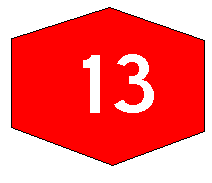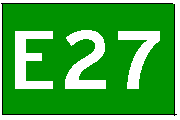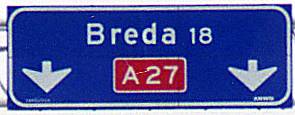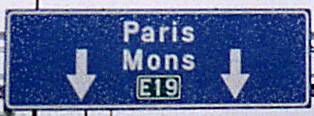
When the European Union was created, one of the big changes came to the European freeways all across Europe. While people did not notice most changes, one of the biggest changes was the signage and the color of the guide signs. Most changes are to bring European freeways up to the standards set by the United States, Canada, and most countries in the Far East. Here are some changes that came in the past decade:
This sign you see above is the sign for the Germany Autobahn. It's a hexagon that looks like that and is has white numbers on a blue shield.

This sign looks similar to Germany, but it's the sign for the Switzerland freeway system. The only main difference is that the sign has white numbers on a red shield.

This sign is the EU route sign. This is found on European freeways provided that the freeway meets the standards. This sign, like any route marker, must be posted with the other highway route markers at distance signs and on control cities.

This is the Auto route sign one normally finds in France. This style is also used in several other countries, but usually in a different color. The France Auto route shield is blue.
Other European highway signs can be found on James Lin's page or on Mark Furqueron's Page
Guide signs
Unlike the United States, the guide signs on European
freeways are required to be blue under the European Union Highway System. An
example of this can be found on Mark Fuerqueron's page.
(Note: you will have to do some scrolling.)
I have built a small table of the
differences one finds between the German Autobahn and the United States
Interstate System. This table is under construction as I speak.
Highway numbers and EU numbers are posted at the
bottom of the distance signs you after pass an exit. They are also
required to be posted at the bottom of signs with control cities and above
arrows in an interchange with yet another European freeway. The only exception
of this is France, where they're posted above the control city sign.


Here's two photos of freeway guide signs in Europe with this feature (photos by Mark Fuerqueron).
Not all countries number their exits. In instance,
Switzerland does not number their exits on their Autobahn and France does not
number exits on all their Auto routes. (Most do -- but a couple that I was on in
France near the France/Switzerland border didn't.)
Like the
This page shows a
sample distance sign in most countries in Europe on their freeways. Germany,
however, uses a slightly different version of distance sign, but the highway
number is posted on the sign. For an example of one, go to Hyde Flippo's Autobahn
page. Netherlands posts distances to control cities on the overhead guide signs
(see left photo above).
Freeway rules
The freeway rules are simple but not enforced by all
countries. Before you go to Europe, you should check with that country's freeway
rules.
These series of rules are patterns that I observed when I
was in Europe in June 1997. Keep in mind that each country has different
rules regarding to their freeways.
Frank from Action maps has just returned from a road trip in
Italy and has this to say:
The main thing I didn't
get to do, regrettably, was photograph signage, etc. because I was the one
doing the driving, and I wasn't alone--there were four of us.
Italian roads are
essentially excellent like all those in Europe, except for the major
differences which are what I would call "cultural," or "traditional." Like,
they don't EXPECT to have a shoulder on each side of the road as wide as a
car, so here you are on a main highway with just two lanes, exactly, with the
tall weeds right up to you wheels. And then there's a bunch
Europe has not accepted
the yellow line as a traffic direction separator. All road striping is
white.
Italians pass anywhere.
You're on a two lane road with traffic coming the other way and the guy behind
you just gets out there and goes past, usually
There are two kinds of
expressways in Italy, really, whereas we only have one
(expressway/Interstate). The Autostrada is the full-blown four lane (or wider
near cities) expressway, with average speeds in the 80 mph range. Watch your
rear-view mirror, however, frequently, and NEVER sit in the passing lane for
longer than it takes to pull your maneuver, because some Mercedes with German
plates doing about 130 mph will blow you off the road.
Autostradi are numbered
with the letter "A", as the A1 the main road from Milano to Roma and Naples.
Funny, though, about route signage. Everywhere within a hundred miles at
countless junctions you will see signs pointing to "A1 ROMA," for example, but
when you're ON the Autostrada, the overhead signs near exits only use the
E-route number, as "E45 ROMA" with a down-pointing arrow. E numbers (shown on
all maps) are never seen off the Autostrada.
All bridges are numbered
in the center median, though, with the sequential number of the overpass and
the route number above.
The second category of
expressway I think was called "Superstrada" or sometimes the sign at an
entrance would just say "To the 4-lane to Florence" in Italian. An example is
the road between Florence and Siena. It is completely controlled access, with
exits about every five miles, but there may be a lower speed limit (like 90
kph), the lanes aren't as wide, and the whole thing just "feels" like a second
class expressway.
These seldom have route
numbers since they were built later than the main road system. On the
kilometer markers where the route number ordinarily goes, the name will be.
For example the above-mentioned road is the "Raccordo Siena-Firenze," the
Florence-Siena Connector.
The ring road around Rome
is known as the Grand Raccordo Anulare, (big bypass, or ring-road), shown on
road maps as the G.R.A.
On the route shields along
the road they actually use the GRA letters as the route number, so within the
green octagon where it would say "A1" it here says "A G.R.A.", the A on the
top line, the G.R.A. below within the octagon.
That's it for now, gotta
go.
Links
There are a few highway links regarding to traffic rules
and freeways in Europe.
Having trouble translating sites? Try this link and follow
directions. Notes
This page was created by Kim Harvey and is not affiliated with any
Department of Transportation.
Most info was provided when I went to Europe in June 1997
and some patterns were found on road maps and by personal experience. If
anyone has better information, they should email me with it.
Special thanks to James Lin for some of the gifs and to Ty
Rodgers for the gifs I used on the distance sign. Most autobahn images came
from this download
site that is in German, but all you need is a photo editor and something
to unzip the files. (Be sure to reduce the photo width by 50%, too.)
Most rules are similar to those in the United States and Quebec.
However, most countries in Europe don't have an numbering scheme like the
Interstate Highway System (except for a few countries and the EU route system),
so you will find odd numbers going east/west and north/south in some countries
and likewise for even numbers.
This photo I've taken in June 1997 is a guide sign leading to the
A-5 in Germany. This photo was taken from a service area about 2 hours south
of Heidelberg. This photo relates to Rule 5 in some extent.
squeaking
in by a foot. And
this is common. After awhile you say, hey, I'm gonna be Italian, here goes!
And when you decide to go for it, you better finish it--no balking. Of course
, your European car will do what you ask of it. We had an Opel Vectra that
moved.
Hi,
of bicycles in your lane
as you round a curve.
![]()